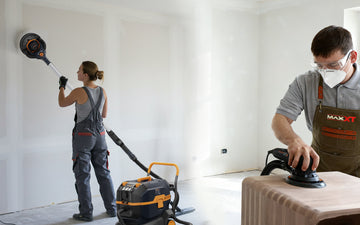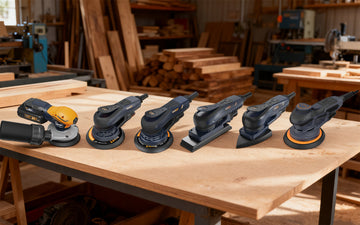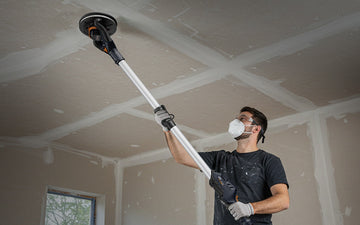The choice between an orbital sander and a drywall sander comes down to the project at hand. Orbital sanders are versatile, general-purpose tools designed for woodworking, finishing, and smaller surfaces. Drywall sanders are specialized tools designed for smoothing walls and ceilings.
In this article, we’ll look at how each tool works, its key features, and typical use cases to help you make an informed decision. Ultimately, choosing the right tool lays the foundation for a professional finish, whether you're sanding a piece of furniture or preparing drywall for paint.
Drywall Sanders Explained
A drywall sander is exclusively designed for preparing drywall and ceiling surfaces, mostly for paint or wallpaper. The tool is purpose-made to smooth out joint compound, filler, and imperfections after drywall installation. Used correctly, it produces a smooth, even surface for the application of paint, wood panelling, tiles, wallpaper, or decorative plaster finishes.
Types
Manual Drywall Sanders
This drywall sander is a compact, handheld tool used for smoothing lower walls, small areas, and tight corners. It's best for touch-ups or sanding in tight spots where a large circular disc can't sand properly.
Pole Sanders
Pole sanders are manual tools with a sanding head attached to a long pole. They are meant to reach high walls and ceilings without ladders or stretching.
Electric Drywall Sanders
Powered models make sanding faster and less tiring. According to Market Reports, over 63% of users prefer working with powered sanders rather than manual models because of their superior efficiency. This also includes cordless drywall sanders, where mobility is more important than continuous power.

Key Features
Swivelling Sanding Head: The sanding head can swivel, so it continuously matches the surface contour, ensuring that it reaches corners, edges, and all uneven spots.
Large Sanding Disk: Drywall sanders have large circular sanding discs measuring from 8.5 to 9 inches (215–225 mm) in diameter. The rotating or oscillating sanding discs are attached to a motorized head.
Adjustable Pole: Electric models have the sanding pad attached at the end of a long, adjustable pole. This feature allows users to sand large walls and high ceilings while standing on the floor. No ladders or scaffolding are needed, which enhances safety. The pole slides out, making it easier to reach high or awkward spots.
Integrated Dust Collection: Most pro drywall sanders have a built-in vacuum attachment. Marketed as dustless drywall sanders, these models connect to a shop vac, capturing up to 99% of the dust generated. This feature is a significant improvement on manual sanders, which require extensive clean-up of health-threatening micro-particles. Pole sanders don't always have dust collection bags.
Integrates Variable Speed Settings: A standard feature on a vacuum sander for drywall is variable speed settings. This feature improves the versatility of the tool, making it suitable for removing bulk material fast, as well as delicate sanding for a refined finish on the final outer coat of drywall.
Flexible Head: The sanding head on a drywall ceiling sander can flex, so it can operate at any angle, reaching all nooks and crannies along the drywall. This ensures consistent contact and pressure, resulting in a flatter, more uniform finish with less effort.
Typical Use Cases
Drywall sanders are custom-designed to sand large drywall surfaces and ceilings in preparation for the final finish. They are often used by contractors juggling numerous sanding jobs simultaneously.
Powered models are popular for jobs in remote, off-grid job sites. They greatly reduce the effort and time needed for sanding large surfaces.
Orbital Sanders Explained
An orbital sander a compact, hand-held power tool commonly used in woodworking and DIY projects to refine surfaces and remove minor imperfections. There two types.
Types
Standard Orbital Sander (Circular Motion)
Standard orbital sanders, also called finishing sanders, move in a simple circular movement, providing smooth finishes, especially on flat wood panels like table tops and cabinet doors, as well as edges.
Random Orbital Sander (Elliptical Motion)
The random orbital sander is an improvement on the orbital sander. With a random orbital sander, the pad spins and oscillates simultaneously in an elliptical pattern. This double action ensures a smooth finish with no swirling marks. This tool is in high demand in industries such as automotive and woodworking, with the global random orbital sander market size projected to reach approximately $2.3 billion by 2032.

Key features
Ease of Use: Both orbital sanders and random orbital sanders are compact and lightweight, making them easy to work with.
Motion:
Orbital sanders: The sanding pad moves in small circular movements.
Random orbital sanders: Combine orbital movement with a random spinning action.
Shape:
Orbital sanders: A square or rectangular pad accommodates standard sandpaper sheets.
Random orbital sanders: Feature a round pad, usually 5 or 6 inches in diameter.
Finished Product:
Orbital sanders: Produce smooth edges and fine finishing work.
Random orbital sanders: Produce a swirl-free finish, even on larger surfaces.
Variable Speed Control:
Orbital sanders: Many basic models offer only one fixed speed, with some higher-end orbital sanders including variable speed control
Random orbital sanders: Variable speed control is more standard on random orbital sanders.
Power Options:
Both types are available in corded versions. Pneumatic versions are also available. for continuous power in large projects and cordless models for mobility.
Typical Use Cases
Orbital sanders are lightweight and easy to use, making them ideal for small woodworking projects like smoothing tables, chairs, and cabinet doors. They’re best suited for fine finishing of wood but can also smooth small paint, metal, and plastic surfaces.
Random orbital sanders, with their combined spinning and oscillating motion, are more versatile. They can remove material fast and produce swirl-free finishes on a wide variety of materials, including wood, metal, plastic, and painted or varnished surfaces.
Corded orbital sanders are the preferred tools for large-scale projects that necessitate a continuous power supply. Cordless electric orbital sanders, fitted with high-capacity rechargeable batteries, are frequently used by homeowners and contractors who prioritise mobility and convenience. Pneumatic versions of random orbital sanders are used in heavy-duty industrial settings.
Drywall Sanders and Orbital Sanders at a Glance
|
Feature |
Drywall Sander |
Orbital Sander |
|
Primarily for |
Walls, ceilings, plaster |
Sanding wood, metals and plastics |
|
Surface area |
Large, flat surfaces |
Small to medium surfaces |
|
Reach |
Telescopic pole (up to 3.2m) |
Handheld only |
|
Dust control |
Efficient built-in vacuum system |
Basic dust bag or port |
|
Weight |
3.9kg+ |
1.3–3kg |
|
Speed range |
1100–1650 RPM |
4000–12,000 OPM |
|
Finish quality |
Functional, not decorative |
Smooth, swirl-free |
|
Cost |
Fairly expensive |
More budget-friendly |
Key Differences between Drywall and Orbital Sanders
1. Primary Purpose
Drywall sanders were designed for a specific purpose: to smooth drywall joints, seams, filler, and ceilings. Orbital sanders are a general-purpose tool for woodworking. Random orbital sanders have an even wider applications, such as smoothing plastic, metal, and painted surfaces.
2. Size and Reach
Orbital sanders are compact, handheld tools that are ideal for smaller workpieces like furniture. Drywall sanders are larger and can reach further, making them suitable for sanding large drywall sheets that would normally require the use of a ladder.
3. Sanding Motion
Drywall sanders use a fairly large circular sanding head that moves in a rotary or orbital motion to cover large areas quickly. Orbital sanders move in small circular movements that can leave sanding marks, while random orbital sanders add an additional movement that prevents swirl marks.
4. Dust Collection
Drywall sanders incorporate dust extraction systems, often connected to vacuums or integrated dust bags, to manage the large amounts of fine dust from joint compound. Orbital sanders, on the other hand, have smaller dust collection systems suited to collect dust generated by small, detailed sanding tasks.
5. Versatility
Drywall sanders are only for drywall, plaster, or ceilings; they can't be used on wood or metal. Orbital sanders can be used to smooth wood, metal, and plastic, but they are not made for heavy duty work like sanding an entire wall.
6. Ease of Use
Drywall sanders can weigh up to 15 lbs, which is quite heavy for work that requires hours of standing. They are mostly designed to be operated with both hands, whereas orbital sanders weigh between 2 and 4 pounds and can easily be operated with one hand.
7. Power Options
Orbital sanders come in both corded and cordless versions. Drywall sanders are mostly corded because operators require consistent power for extended jobs.
8. Cost and Accessibility
Being specialized, drywall sanders are quite costly. They are mostly purchased by professionals or contractors in the construction industry or for renovations. Orbital sanders are inexpensive, and most homeowners who have a workshop own one of these tools.

How to Choose Between a Drywall and an Orbital Sander
Choosing between a drywall and an orbital sander is determined by what you will need the tool for. If you are installing drywall, you'll need a drywall sander – they are designed for this purpose. You don't dare use a random orbital sander on drywall; it's far too aggressive for the material.
On the other hand, if you are refinishing old furniture or renovating the wood panelling in the den, you'll need an orbital sander. It will also come in handy for all those other small projects waiting to be tackled.
These two tools complement each other so well that many home and professional workshops stock both.
FAQs
1. Can you use an orbital sander on drywall?
Orbital sanders are not ideal for drywall because they can leave swirl marks and damage the drywall surface.
2. What’s the main difference between a drywall sander and an orbital sander?
A drywall sander is built for large, flat wall and ceiling surfaces, while an orbital sander is more versatile for wood, furniture, and smaller projects.
3. Do orbital sanders have dust collection systems?
Yes, many have, but they are less effective for collecting fine dust particles.
4. Don't orbital sanders leave swirl marks?
Yes, standard orbital sanders can leave swirl marks if not used correctly, but random orbital sanders with their double-action movement won't leave any swirl marks.
5. Are drywall sanders worth the investment?
For professionals and contractors, yes – drywall sanders save significant time and reduce cleanup. For occasional DIY projects, renting may be more cost-effective.
Conclusion
Deciding between an orbital sander and a drywall sander comes down to versatility versus specialization: orbital sanders are best for woodworking and smaller surfaces, while drywall sanders are specialized tools for smoothing walls and ceilings. This distinction makes the choice between these tools straightforward.
For businesses, contractors, and distributors looking to expand their offerings, we invite you to explore our full range of professional-grade sanders. Call our team today and explore lucrative partnership opportunities with a leading power tool manufacturer.




